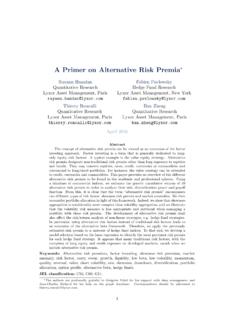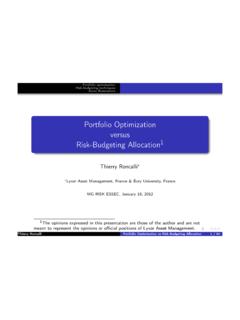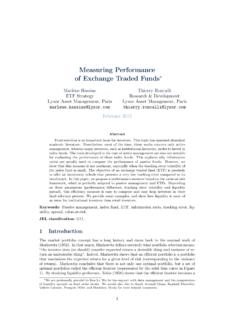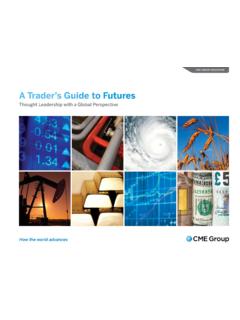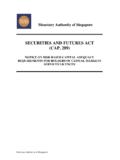Transcription of Keep Up The Momentum - thierry-roncalli.com
1 keep Up The Momentum Thierry RoncalliQuantitative ResearchAmundi Asset Management, 2017 AbstractThe Momentum risk premium is one of the most important alternative risk premiaalongside the carry risk premium. However, it appears that it is not always well under-stood. For example, is it an alpha or a beta exposure? Is it a skewness risk premiumor a market anomaly? Does it pursue a performance objective or a hedging objective?What are the differences between time-series and cross-section Momentum ? What arethe main drivers of Momentum returns? What does it mean when we say that it is aconvex and not a concave strategy?
2 Why is the Momentum risk premium a diversifyingengine, and not an absolute return strategy?The goal of this paper is to provide specific and relevant answers to all these ques-tions. The answers can already be found in the technical paper Understanding theMomentum Risk Premium published recently by Jusselinet al.(2017). However, theunderlying mathematics can be daunting to readers. Therefore, this discussion paperpresents the key messages and the associated financial insights behind these the main findings, one result is of the most importance.
3 To trend is todiversify in bad times. In good times, trend-following strategies offer no significantdiversification power. Indeed, they are beta strategies. This is not a problem, sinceinvestors do not need to be diversified at all times. In particular, they do not needdiversification in good times, because they do not want that the positive returns gen-erated by some assets to be cancelled out by negative returns on other assets. This iswhy diversification may destroy portfolio performance in good times. Investors onlyneed diversification in bad economic times and stressed diversification asymmetry is essential when investing in beta strategies likealternative risk premia.
4 On the contrary, this diversification asymmetry is irrelevantwhen investing in absolute return strategies. However, we know that generating perfor-mance with alpha strategies is much more difficult than generating performance withbeta strategies. Therefore, beta is beautiful, but convex beta is precious and risk premia, Momentum is one of the few strategies to offer this diversificationasymmetry. This is why investing in Momentum is a decision of portfolio construction,and not a search for : Momentum , trend-following, diversification, classification:C50, C60, G11.
5 I am very grateful to my co-authors Paul Jusselin, Edmond Lezmi, Hassan Malongo, C ome Masselin andTung-Lam Dao for sharing their views on these topics. The working paper Understanding the MomentumRisk premium: An In-Depth Journey Through Trend-Following Strategies can be downloaded from I would also like to thank Alexandre Burgues, Jean-Thomas Heissat,Edouard Knockaert, Rapha el Sobotka and Bruno Taillardat for their helpful comments and Up The Momentum '&$%Key Takeaways The performance of Momentum strategies depends on three main parameters: The absolute value of Sharpe ratios The correlation matrix of asset returns The moving average duration to estimate the trends Time-series Momentum likes zero-correlated assets.
6 This is why time-series momentummakes sense in a multi-asset framework. Cross-section- Momentum likes highly correlated assets. This is why cross-section mo-mentum makes sense within a universe of homogenous assets, a universe of stocksthat belong to the same region. Short-term Momentum is more risky than long-term Momentum . Therefore, the cross-section dispersion of short-term Momentum returns is broader than the cross-sectiondispersion of long-term Momentum returns. The Sharpe ratio of long-term Momentum is higher than the Sharpe ratio of short-termmomentum.
7 The choice of the moving average estimator is more crucial for short-term momentumthan for long-term Momentum . Too much leverage can be harmful for the strategy, since Momentum portfolios are nothomothetic transformations with respect to the portfolio s leverage. The payoff of a trend-following strategy is a long straddle option profile. Therefore,trend-following strategies exhibit a convex payoff. Trend-following portfolios are not absolute return strategies. In the long-run, trend-following strategies present a low moderate correlation with traditional asset , it is an illusion due to long-term averaging, since they present either a highpositive or a high negative beta.
8 The main motivation of Momentum investing is diversification, not performance. Theconvexity of trend-following strategies mitigates the risk of diversified portfolios inbad times. This is why Momentum strategies must be located in diversifying buckets,and not in absolute return buckets. Therefore, analysing the risk/return trade-off ofmomentum strategies on a standalone basis does not make sense. It follows that Momentum risk premium is key for building an alternative risk Up The Momentum1 Defining Momentum strategiesMomentum is one of the oldest and most popular trading strategies in the investment indus-try.
9 For instance, Momentum strategies are crucial to commodity trading advisors (CTAs)and managed futures (MFs) in the hedge funds industry. They also represent the basic trad-ing rules that are described in the famous Turtle trading experiment conducted by RichardDennis and William Eckhardt in 1980s1. Momentum strategies are also highly popularamong asset managers. For instance, the four-factor model of Carhart (1997) is the stan-dard approach for analysing the performance of equity asset managers. Another importantfact concerns the relationship between options and Momentum .
10 Indeed, it is well-knownthat the manufacturing of structured products is based on Momentum strategies. Hedgingdemand from retail and institutional investors is therefore an important factor explainingthe Momentum Momentum investment style is often opposed to the contrarian investment style. Inthe first approach, the investor follows the market or the current trend of some assets. This iswhy we also speak about trend-following strategies. In the second approach, the investor goesagainst the market or the current trend of some assets. This investment style is also knownas the mean-reverting or reversal strategy.



